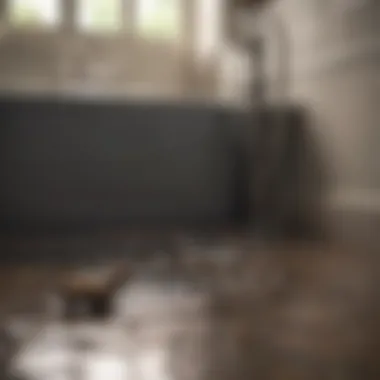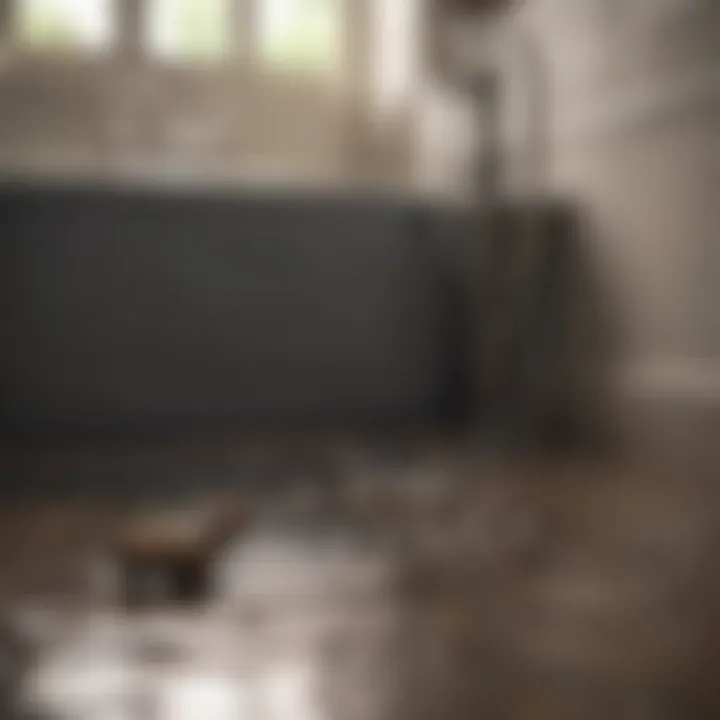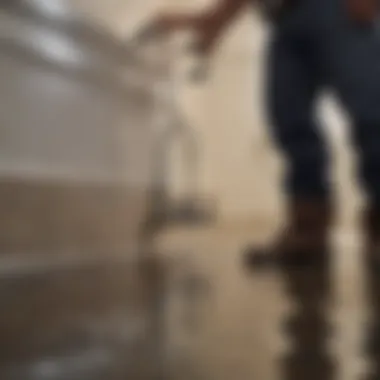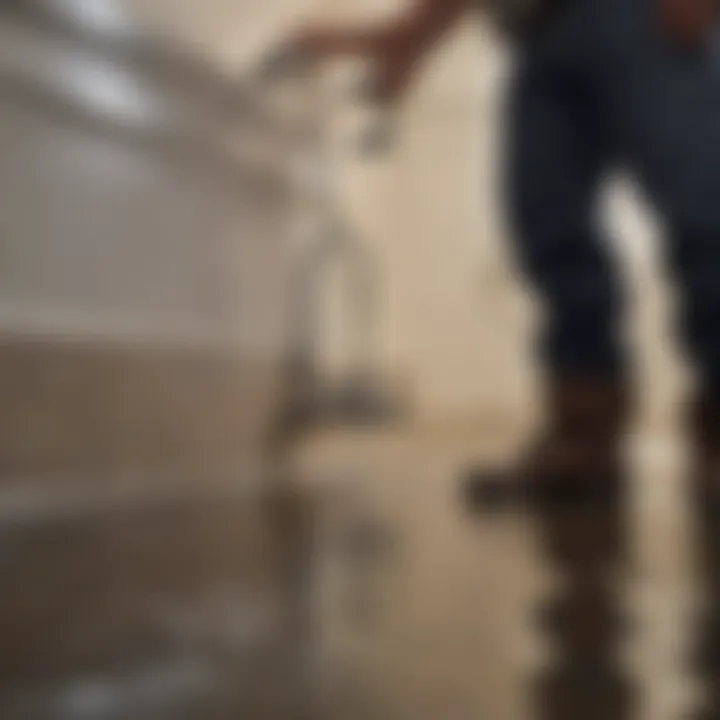Effective Strategies for Unclogging Your Tub Drain


Intro
Unclogging a tub drain that is filled with standing water can be a frustrating experience. Many homeowners encounter this issue, which not only disrupts daily routines but also poses a risk of water damage and sanitation problems. Understanding how to effectively address this situation is essential for maintaining a functional bathroom.
This article equips readers with a detailed exploration of various strategies, tools, and methods to unclog a tub drain efficiently. Emphasis is placed on practical DIY approaches as well as scenarios where expert intervention may be necessary. By the end of this article, you will have a comprehensive grasp of effective techniques and preventive measures to keep your tub drain functioning smoothly.
Understanding Clogs
Clogs in tub drains often occur due to a combination of hair, soap residues, and foreign objects. These blockages can lead to standing water, creating an inconvenient and unsightly problem. Being familiar with the common causes of blockages is the first step in preventing and addressing these issues effectively.
Here are some common reasons for clogs:
- Hair accumulation
- Soap scum buildup
- Foreign objects such as toys
- Mineral deposits from hard water
Knowing these factors can help homeowners take proactive measures to minimize clogs.
Techniques for Unclogging a Tub Drain
1. Use a Plunger
A plunger can be an effective tool for clearing minor clogs. Ensure there is enough water to cover the plunger’s suction cup. Place the cup over the drain and apply firm pressure to create suction. After several pumps, remove the plunger to see if the water begins to drain.
2. Baking Soda and Vinegar
A natural remedy involves pouring half a cup of baking soda followed by an equal amount of vinegar down the drain. This combination creates a chemical reaction that can dissolve certain types of clogs. After letting it sit for about 30 minutes, flush the drain with hot water.
3. Drain Snake
A drain snake is a long, flexible tool that can reach into pipes to dislodge blockages. Insert the snake into the drain until you meet resistance. Turn the handle to break up the clog and pull back any debris.
4. Wet/Dry Vacuum
If accessible, a wet/dry vacuum can be an effective solution for sucking up standing water and debris from the drain. Make sure to set it to liquid mode. Place the hose over the drain and create a tight seal, then turn it on to suck out the clog.
5. Chemical Drain Cleaners
Chemical cleaners can be a last resort for persistent clogs. However, it's crucial to follow the manufacturer's instructions carefully. These products can be harsh, and repeated use may damage pipes.
Remember: Avoid using chemical cleaners if you have old or damaged plumbing, as they can exacerbate existing issues.
When to Call a Professional
Sometimes clogs may be beyond DIY solutions. If multiple drain options fail or if you notice recurrent issues, it might be time to consult a plumbing professional. Signs that indicate professional intervention is necessary include:
- Overflows in multiple drains
- Strange odors coming from the pipes
- Flushing toilets and running taps that do not resolve the blockage
Assessing the problem early can prevent significant damage and costly repairs.
Preventive Measures
To avoid the hassle of unclogging in the future, consider implementing these preventative strategies:
- Install a drain screen to catch hair and debris
- Regularly clean your drain by using baking soda and vinegar
- Avoid disposing of any foreign objects in the tub
Implementing these proactive measures can save time and reduce stress, ensuring your tub drain operates smoothly.
Understanding the Problem


Recognizing and understanding the problem of clogged tub drains is crucial for effective resolution. Standing water is not just an inconvenience; it can lead to hygiene issues, unpleasant odors, and even significant property damage if left unaddressed. The importance of diagnosing the issue lies in identifying the type and severity of the blockage, guiding decisions on the most appropriate method for unclogging.
Nature of Clogs
Clogs in tub drains vary widely in nature. They might consist of hair, soap scum, or mineral deposits. Each type of clog requires a different approach for removal. For instance, hair accumulations often need manual removal, while soap scum might dissolve with certain chemicals. Understanding the specific type of clog can drastically improve the efficiency of any attempted solution. A thorough examination of the drain allows for a targeted effort rather than guesswork. This attention to detail can also prevent further damage to plumbing fixtures.
Common Causes of Standing Water
Standing water typically arises from several common causes. Hair is a frequent offender, as it tends to tangle and build up in the drains. Soap residue also contributes to the problem, creating a sticky surface that traps even more debris. Other possible culprits include foreign objects that accidentally get washed down the drain, such as toys or sanitary products. This understanding can help homeowners anticipate future issues and take preventive measures. Regular cleaning and careful monitoring of what goes down the drain play a significant role in minimizing these problems.
Impact of Clogs on Drainage
The impact of clogs on drainage is significant and multifaceted. When drains become obstructed, it disrupts the flow of water, leading to backups and potential flooding in the bathroom. Moreover, chronic clogs can cause serious plumbing issues, including pipe bursts and leaks. In severe cases, prolonged standing water can lead to mold growth, presenting health risks to occupants. Therefore, addressing clogs promptly is not merely a matter of convenience but essential for maintaining the integrity of the plumbing system and ensuring household safety.
"Understanding the specifics behind clogs can determine the success of your unclogging efforts. A targeted approach is always the best practice."
This initial understanding sets the foundation for effective solutions by combining practical knowledge with attentiveness to ongoing maintenance tasks.
Initial Assessment
Before attempting to unclog a tub drain with standing water, it is essential to conduct a thorough initial assessment. This phase is significant, as it helps to understand the nature of the clog and decide on the best method for removal. Without this assessment, attempts to resolve the issue may be inefficient or could potentially cause further damage to plumbing systems.
Evaluate the Severity of the Clog
Start by evaluating the severity of the clog. Is the water draining slowly, or is it completely blocked? A partial blockage may allow some water flow, giving clues about the nature of the obstruction, while a total blockage means no water is moving at all. Knowing how severe the clog is can guide you in choosing the right tools and methods. For instance, a simple plunger may work for minor blockages, whereas a more robust solution like a plumbing auger might be necessary for severe cases. Consider how long the drain has been obstructed as well; a long-term clog may require more aggressive measures.
Identify the Location of the Blockage
Next, focus on identifying the location of the blockage. This is crucial because certain obstruction locations may require specialized tools. Drainage systems often have traps or bends that can trap debris. If you suspect the blockage is in the trap, localizing this area can save time in attempting to resolve the issue. Be sure to check all relevant points, including areas under the tub where clogs often occur due to hair buildup and soap residue.
Inspect for Additional Issues
Finally, it is essential to inspect for additional issues beyond the primary blockage. Sometimes, the underlying cause of standing water can be tied to broader plumbing problems, such as tree roots invading the sewer line or incorrect installation of plumbing fixtures. Pay attention to any unusual smells, gurgling sounds, or slow drainage in other areas of the home. These signs may indicate that the clog is part of a more extensive problem, which should be addressed as soon as possible to prevent further damage or expensive repairs.
Conducting an initial assessment can save time and money, ensuring that the right unclogging method is chosen from the onset.
Understanding these aspects helps homeownwers tackle clogs efficiently while being prepared for any complications that may arise.
Essential Tools and Materials
Understanding the right tools and materials for unclogging a tub drain is crucial for effectively dealing with standing water. Using appropriate equipment enables homeowners to address clogs safely and efficiently. Various tools can make the process easier, while household items offer accessible solutions without the need for extensive plumbing knowledge.
It is essential to select tools that not only fit the specific situation but also are easy to use. The correct combination can save time and prevent potential damage to the plumbing system. Let's explore both plumbing tools and effective household items you can use to combat clogs.
Plumbing Tools Overview
Plunger
A plunger is one of the most basic yet effective tools for unclogging drains. It uses air pressure to dislodge clogs and can be particularly useful for minor blockages in a tub. Its key characteristic is the rubber suction cup at the end, which creates a vacuum seal over the drain hole. Because it requires no chemicals, it is a popular choice in households.
One unique feature of the plunger is its versatility. It can also be used on toilets and sinks. However, it may not be effective for deeper clogs, requiring more specialized tools.
Drain Snake
A drain snake, or plumber's snake, is a flexible tool designed specifically for clearing more stubborn blockages. The snake can reach deeper into pipes than a plunger, making it beneficial when clogs are further down the drain. Its main advantage lies in its ability to break apart or retrieve the materials causing the obstruction.
One distinct feature of the drain snake is its coil design, which allows it to navigate bends in pipes effectively. However, using a drain snake requires some technique to avoid damaging the pipes or pushing the clog further down.
Plumbing Auger


A plumbing auger is a more advanced tool often used for serious clogs. It has a spiral blade that helps to break up tough blockages and can reach even deeper areas than a standard drain snake. Its robust design is a definite advantage when faced with heavy clogs that do not respond to simpler tools.
The plumbing auger's unique feature is its ability to connect to a power source, allowing for automated operation. While it is effective, it can also be expensive and may require training to operate safely and efficiently.
Household Items for Unclogging
Baking Soda and Vinegar
Baking soda and vinegar form a natural chemical reaction that can help dislodge minor clogs. The mixture creates bubbles that can loosen debris in drains, making it a popular choice for eco-conscious homeowners seeking non-toxic solutions.
The key characteristic here is the simplicity of the ingredients. Both are commonly found in kitchens, which makes this method accessible. However, it may not work on severe blockages, and caution should be exercised because excessive use could lead to unwanted chemical reactions.
Salt and Hot Water
Using salt and hot water can also be an effective method to tackle clogs. Salt helps to break down build-up, while hot water can flush materials through the pipes. This method is especially useful for grease-related blockages that accumulate over time.
The main benefit is its low cost and ease of access. However, some pipes may not withstand extreme heat, so it is important to use warm, not boiling, water to avoid damage.
Dish Soap
Dish soap is often overlooked when it comes to unclogging drains. It works as a lubricant, helping to break down greasy substances. When combined with hot water, it can be a powerful ally against clogs caused by soap scum or hair.
A key benefit of dish soap is its widespread availability and safety for all types of plumbing. However, it may be less effective in cases of severe blockages, where stronger tools or methods might be necessary.
Methods for Unclogging a Tub Drain
Unclogging a tub drain requires practical skills and techniques that can vary based on the nature of the blockage. Addressing this issue promptly is essential for maintaining the overall plumbing system in the home. Not only does a clogged drain create inconvenience, but it can also lead to longer-term damage if not resolved quickly.
This section outlines several effective techniques for unclogging a tub drain, presenting a range of options that can cater to different situations and levels of severity. Each method comes with its own benefits and considerations, ensuring that homeowners can find an approach that fits their specific needs. By utilizing these methods, one can restore proper drainage, reduce the risk of future clogs, and maintain a functional and pleasant bathing environment.
Using a Plunger
Employing a plunger is one of the most straightforward methods for unclogging pipes. A standard cup plunger is typically effective for tub drains, as its design creates a vacuum seal that can dislodge blockages. To use a plunger correctly, fill the tub with some water, covering the base of the plunger. Position the plunger over the drain and push down firmly. Then, pull up quickly, repeating this action several times.
- Make sure to seal any overflow drains to maximize suction.
- The force generated can help break up hair, soap scum, and other debris blocking the drain.
Applying a Drain Snake
When a plunger cannot resolve the issue, a drain snake is a suitable next step. A drain snake is a flexible tool designed to navigate the twists and turns of plumbing. To use it, insert the snake's tip into the drain. Slowly push it through the pipe until resistance is felt, then rotate the handle to latch onto the clog.
- Pull the snake back while continuing to rotate it. This action can often pull up hair clogs or other materials.
- Make sure to clean the snake after use to avoid transferring residue during future applications.
Chemical Drain Cleaners
If mechanical methods fail, chemical drain cleaners can provide a more forceful solution. These cleaners contain strong corrosive elements designed to break down clogs. However, one must approach this option with caution.
- Read the instructions carefully to understand how to use them effectively.
- Avoid mixing different chemical cleaners, as this can create dangerous reactions.
- While effective, these are not always the most environmentally friendly option.
Baking Soda and Vinegar Technique
The combination of baking soda and vinegar presents a natural approach to unclogging a drain. This method leverages a chemical reaction to break down debris. Begin by pouring about half a cup of baking soda into the drain, followed by half a cup of vinegar. You will see fizzing as the two substances react.
- Let the mixture sit for about 30 minutes to allow it to penetrate the clog.
- Afterward, follow up with boiling water to flush the debris away.
- This method is both safe for pipes and environmentally friendly.
When to Seek Professional Help
When dealing with a clogged tub drain filled with standing water, there are various strategies to clear it. Even with various DIY methods available, there are situations where professional assistance becomes necessary. Recognizing when to call in a plumber can save time, effort, and ultimately money in repairs. This section will articulate important signs of a significant plumbing issue and detail how to select a reliable plumber.


Signs Indicating Professional Intervention
There are several indicators that suggest a blockage may be beyond basic remedies. Here are a few critical signs to look out for:
- Persisting Clogs: If multiple attempts to unclog your drain fail, it may be time to consult a professional.
- Frequent Backups: A recurring issue can suggest deeper problems within the plumbing system.
- Unusual Odors: Foul smells can indicate stagnant water due to clogs, potentially signaling a more serious issue.
- Increased Water Pressure: Sudden changes in water pressure can indicate blockage or pipe damage.
- Water Buildup in Other Drains: If other drains are also slow or backed up, this may point to a wider plumbing problem.
If you notice any of these signs, it is advisable to seek assistance.
Choosing a Reliable Plumber
Finding the right plumber can be daunting but is crucial for effective service. Here are factors to consider when selecting a plumbing professional:
- Experience and Qualifications: Verify the plumber's background and check for licenses.
- Reputation: Look for reviews and testimonials online. Websites like Reddit, or local forums can provide insights.
- Cost Estimates: Get multiple estimates before making a decision. This will help ensure you receive fair pricing.
- Availability: Ensure the plumber is available in case of urgent needs.
- Warranty and Guarantees: Ask if the plumber offers warranties for their workmanship. This can provide peace of mind regarding the service.
"Choosing the right professional can prevent further damage and potential headaches in the future."
Establishing a reliable plumber can ease the stress of plumbing issues, allowing you to return to regular activities without delay.
Preventative Measures
Preventing clogs is as important as dealing with them. You can spare yourself from future troubles with your tub drain by establishing effective preventative measures. Not only do these strategies save you time and money, they also ensure that water flows freely in your plumbing system. Investing in regular maintenance can significantly reduce the frequency and severity of clogs, keeping your drains healthy.
Regular Drain Maintenance Practices
One of the most effective ways to prevent clogs is through regular maintenance. This includes actions like clearing debris and buildup before it turns into a serious blockage. You may perform the following practices:
- Monthly Cleaning: Take time to inspect and clean your drains at least once a month. This routine keeps any hair, soap, or other debris from accumulating.
- Hot Water Flush: Running hot water down the drain periodically can help dissolve soap scum and grease, making it more difficult for blockages to form.
- Professional Inspections: Hiring a plumber for an annual inspection can catch issues before they become major problems.
Performing these tasks regularly can help maintain a clear tub drain, minimizing future issues.
Utilizing Drain Covers
Drain covers are simple but effective tools that can help keep your tub drain clear. When used properly, they can act as a barrier to catch debris before it enters the plumbing system. Consider the following:
- Select Appropriate Covers: Choose a cover that fits snugly in your tub drain. There are various types available which can cater to specific needs.
- Routine Checks: Make it a habit to check the cover regularly for any hair and debris buildup. Cleaning the cover can enhance its effectiveness.
- Educate Household Members: Ensure everyone in your home understands the importance of drain covers and encourages them to use them consistently.
By taking these steps, you can avoid larger problems posed by lack of protection in your drains.
Mindful Product Usage
Being aware of the products you use in your tub can significantly reduce clogging. Many common household products can inadvertently contribute to plumbing issues. Here are some guidelines:
- Choose Drain-Friendly Products: Prefer biodegradable soaps and shampoos that don’t leave behind excessive residues.
- Limit Oil and Grease: Avoid pouring any oils or greasy substances down the drain. These can accumulate and solidify, making it difficult to clear clogs.
- Educate on Disposal: Dispose of items such as wipes, cotton swabs, and hygiene products properly instead of flushing them down the toilet or draining them.
Being mindful while using products enhances the functionality of the drain and can prevent standing water.
Remember: Taking proactive steps in drainage management not only keeps your system operational but also extends its lifespan. Proper care leads to less frequent and less severe clogging.
Utilizing these preventative measures establishes a foundation for a well-maintained plumbing system. Being diligent can spare you future troubles associated with standing water and clogged drains.
Closure
Unclogging a tub drain that has standing water can be both frustrating and inconvenient. However, this issue represents a common household problem that can often be resolved with the right strategies. In this conclusion, we will summarize the key elements discussed in the article while emphasizing the significance of effective drain maintenance practices.
Recap of Effective Strategies
When presented with a clogged tub drain, various techniques can be employed. For instance, using a plunger is one of the most accessible initial methods. This tool can create enough pressure to dislodge minor blockages. If a plunger fails, applying a drain snake may also prove effective as it dives deeper into the plumbing system, addressing stubborn clogs. Chemical drain cleaners can offer a more aggressive approach but should be used with caution, given their corrosive properties. Household items, such as baking soda and vinegar, present a non-toxic alternative that can achieve results without harming pipes.
When clogs persist or if additional issues arise, recognizing the signs that warrant professional help is crucial. Ignoring these can lead to more severe damage and expensive repairs. Regular maintenance practices, including inspection and mindful product usage, can mitigate the risk of future clogs. By adopting preventative measures, homeowners maintain an optimal drain function, significantly reducing the likelihood of standing water.
Final Thoughts on Drain Maintenance
Effective drain maintenance is a vital aspect of maintaining a functional and hygienic bathroom environment. Understanding the nature and causes of clogs allows homeowners to address issues proactively. Routine maintenance not only extends the life of plumbing systems but also enhances the overall comfort and functionality of home spaces.
Homeowners should engage in practices that promote cleanliness and proper usage of their drains. This includes using drain covers, conducting regular inspections, and being cautious with the products used down the drain. By fostering an awareness of drain health, it is possible to minimize the frustrations associated with clogs, ensuring that the tub remains in optimal condition. Regular attention to these aspects can save time and money, allowing individuals to focus on enjoying their home rather than dealing with inconvenient plumbing issues.















